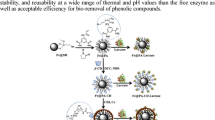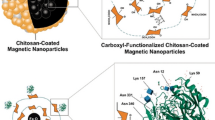Abstract
Phenolic compounds exhibit toxic effects and there are still many challenges to find an efficient way for degradation and removal of phenol especially from food. In the present study, magnetically immobilized laccase was prepared and applied as an efficient heterogeneous biocatalyst for biodegradation of phenol from sesame oil. Laccase was attached covalently to magnetic Fe3O4 nanospheres and nanorods, and the characteristics of the immobilized enzyme were studied. The magnetic supports were analyzed by scanning electron microscopy, X-ray diffraction, vibrating sample magnetometry, and Fourier-transform infrared spectroscopy. Storage stability analysis of immobilized enzyme showed that more than 70% of initial activity was kept after 15 days at 4 °C. More than 70% phenol degradation was achieved and a 60% decrease in the activity of immobilized laccase was observed after 20 independent cycles. The development of enzyme immobilization techniques on magnetic supports may expand the potential applications of heterogeneous biocatalysts in food industries.
Graphic Abstract









Similar content being viewed by others
Abbreviations
- ABTS:
-
2,2′-Azino-bis 3-ethylbenzthiazoline-6-sulfonic acid is a peroxidase substrate suitable for enzyme activity measurement.
- APTES:
-
3-Triethoxysilylpropylamine was used for amination
- FT-IR:
-
Fourier-transform infrared
- IU:
-
The enzyme international unit, One U is defined as the amount of the enzyme that transforms one µmole of substrate / minute.
- PAMAM:
-
Poly(amidoamine) is a type of dendrimer containing repetitively branched subunits of amide and amine moieties that is commonly used for surface modification.
- PEG:
-
Polyethylene glycol
- TEOS:
-
Tetraethyl orthosilicate
- VSM:
-
Vibrating sample magnetometer, was used to determine magnetization properties of nanostructured iron oxide supports.
- XRD:
-
X-ray diffraction, was used to study the structure, composition, and physical properties of synthesized MNPs.
- SEM:
-
Scanning electron microscope was used as a sample imaging tool
References
Mattinen ML, Struijs K, Suortti T, Mattila I, Kruus K, Willfor S, Tamminen T, Vincken JV (2009) BioResources 4:482–496
Villegas LGC, Mashhadi N, Chen M, Mukherjee D, Taylor KE, Biswas N (2016) Curr Pollut Rep 2:157–167
Wang F, Hua Y, Guo C, Huang W, Liu CZ (2012) Bioresour Technol 110:120–124
Tavares APM, Pinho B, Rodriguez O, Macedo EA (2012) Proc Eng 42:226–230
Zeb A, Muhammad B, Ullah F (2017) Food Meas 11:1362–1369
Couto SR, Herrera JLT (2006) Biotechnol Adv 24:500–513
Mate DM, Alcalde M (2016) Microb Biotechnol 10:1457–1467
Kunamneni A, Camarero S, Burgos CG, Plou FJ, Ballesteros A, Alcalde M (2008) Microb Cell Fact 7:32
Maeda K, Yagita H, Omata K, Fujioto K (1992) J Mol Catal 71:347–355
Antebi S, Arya P, Manzer LE, Alper H (2002) J Org Chem 67:6623–6631
Jesionowski T, Zdarta J, Krajewska B (2014) Adsorption 20:801–821
Kango S, Kalia S, Celli A, Njuguna J, Habibi Y, Kumar R (2013) Pro Polym Sci 38:1232–1261
Huang D, Deng C, Zhang X (2014) Anal Methods 6:7130–7141
Sun J, Zhang Y, Yang F, Ma M, Xiong F, Gu N (2018) Chin Sci Bull 64:842–853
Bagheri M, Rodríguez H, Swatloski RP, Spear SK, Daly DT, Rogers RD (2008) Biomacromol 9:381–387
Roberts JC, Bhalgat MK, Zera RT (1996) J Biomed Mater Res 30:53–65
Boas U, Christensen JB, Heegaard PMH (2006) Dendrimers in medicine and biotechnology. RSC, Cambridge
Amin R, Khorshidi A, Fallah Shojaei A, Rezaei S, Faramarzi MA (2018) Int J Biol Macromol 114:106–113
Zhang Z, Kong J (2011) J Hazard Mater 193:325–329
Cui Y, Li Y, Yang Y, Liu X, Lei L, Zhou L, Pan F (2010) J Biotechnol 150:171–174
Ge F, Li M, Ye H, Zhao B (2012) J Hazard Mater 211:366–372
Khodadust R, Unsoy G, Yalcın S, Gunduz G, Gunduz U (2013) J Nanopart Res 15:1488
He K, Xu C, Zhen L, Shao W (2007) Mater Lett 61:3159–3162
Patel SK, Kalia VC, Choi JH, Haw JR, Kim IW, Lee JK (2014) J Microbiol Biotechnol 24:639–647
Mogharabi M, Kiani M, Aryanejad S, Imanparast S, Amini M, Faramarzi MA (2018) Adv Synth Catal 360:3563–3571
Rezaei S, Tahmasbi H, Mogharabi M, Firuzyar S, Ameri A, Khoshayand MR, Faramarzi MA (2015) J Taiwan Inst Chem Eng 56:113–121
Slinkard K, Singleton VL (1977) Am J Enol Vitic 28:49–55
Liu J, Liu S, Zhuang S, Wang X, Tu F (2013) Ionics 19:1255–1261
Jang JH, Lim HB (2010) Microchem J 94:148–158
Li QY, Wang PY, Zhou YL, Nie ZR, Wei Q (2016) J Sol-Gel Sci Technol 78:523–530
Wang P, Li Q, Zhou Y, Wei Q, Nie Z (2016) Key Eng Mater 697:749–755
Wan J, Yao Y, Tang G (2007) Appl Phys A Mater Sci Process 89:529–532
Hwang ET, Gu MB (2013) Eng Life Sci 13:49–61
Garcia-Galan C, Berenguer-Murcia Á, Fernandez-Lafuente R, Rodrigues RC (2011) Adv Synth Catal 353:2885–2904
Leonowicz A, Cho N, Luterek J, Wilkolazka A, Wojtas-Wasilewska M, Matuszewska A, Hofrichter M, Wesenberg D, Rogalski J (2001) J Basic Microbiol 41:185–227
Forootanfar H, Faramarzi MA (2015) Biotechnol Prog 31:1443–1463
Zhu J, Sun G (2012) React Funct Polym 72:839–845
Osma JF, Toca-Herrera JL, Rodríguez-Couto S (2010) Bioresour Technol 101:8509–8514
Sar M, Akgol S, Karatas M, Denizli A (2006) Ind Eng Chem Res 45:3036–3043
Sheldon RA (2007) Adv Synth Catal 349:1289–1307
Forde J, Tully E, Vakurov A, Gibson TD, Millner P, Ó'Fágáin C (2010) Enzym Microb Technol 46:430–437
Silva AM, Tavaresa APM, Rocha CMR, Cristóvão RO, Teixeira JA, Macedo EA (2012) Process Biochem 47:1095–1101
Rekuć A, Jastrzembska B, Liesiene J, Bryjak J (2009) J Mol Catal B 57:216–223
Cabana H, Jones JP, Agathos SN (2007) J Biotechnol 132:23–31
Spinelli D, Fatarella E, Di Michele A, Pogni R (2013) Process Biochem 48:218–223
Çetinus ŞA, Öztop HN (2003) Enzym Microb Technol 32:889–894
Parmar I, Rpasinguhe HPV (2012) Bioresour Technol 124:433–439
Alver E, Ülkü Metin A (2017) Int Biodeterior Biodegrad 125:235–242
Acknowledgements
Support of this study by the research council of University of Guilan is gratefully acknowledged. Also many thanks for so much help to Professor Wolfgang Bensch and his working group at the Institute for Inorganic Chemistry (CAU, Kiel), to PD Dr. Christoph Plieth of Centre of Biochemistry and Molecular Biology (BiMo; CAU, Kiel), and to Professor Mohammad Ali Faramarzi and his working group, especially M. Mogharabi, at Tehran University of Medical Sciences.
Author information
Authors and Affiliations
Corresponding authors
Ethics declarations
Conflict of interest
The authors declared no conflict of interest.
Additional information
Publisher's Note
Springer Nature remains neutral with regard to jurisdictional claims in published maps and institutional affiliations.
Rights and permissions
About this article
Cite this article
Amin, R., Khorshidi, A., Bensch, W. et al. Degradation of Sesame Oil Phenolics Using Magnetic Immobilized Laccase. Catal Lett 150, 3086–3095 (2020). https://doi.org/10.1007/s10562-020-03226-8
Received:
Accepted:
Published:
Issue Date:
DOI: https://doi.org/10.1007/s10562-020-03226-8




